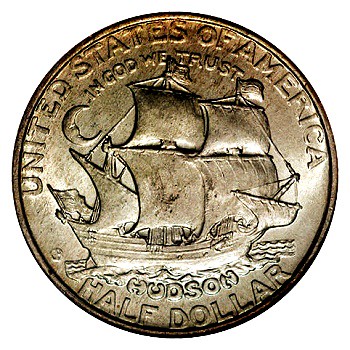
PREV ARTICLE
NEXT ARTICLE
FULL ISSUE
PREV FULL ISSUE
SHIPS ON AMERICAN COINAGE
An article by Charles Morgan and Hubert Walker in CoinWeek caught my eye with some great photos of U.S. coins featuring ships. Here's an excerpt - be sure to read the complete article online.
-Editor
Outside of the eagle, Lady Liberty and allegorical Native American motifs, no symbol is used on American coins as prolifically as ships. The story of this country – indeed, the story of the New World – is full of great voyages, larger-than-life personalities, and the mighty ships that made it all possible. The following is a short history of some of the more significant vessels and their corresponding coins. The Halve Maen (Half Moon) – The Netherlands – 1608-1618
Hudson had attempted to find such a route twice before, and believed he was heading towards Cathay (China) when he arrived at North America’s northeastern shores. Hudson and Halve Maen made it all the way to present day Albany along the “Hudson” River before deciding his ship could no longer proceed up the shallow waters. So he turned back, finding no route to the Orient. Amazingly, Halve Maen was in service for only eleven years. The ship was attacked and destroyed during an English attack on Jakarta, Indonesia in 1618. Replicas have been built over the years, including one commissioned by the Netherlands in 1909 to celebrate the 300th anniversary of Hudson’s voyage. That ship outlasted the original by fourteen years, before a fire consumed it in 1934. Today, another replica (built in 2005) sails along the Hudson River, owned and operated by a non-profit organization. Halve Maen appears on the 1935 Hudson Sesquicentennial half dollar, commemorating the 150th anniversary of the city of Hudson, New York. It was designed by Chester Beach from a medal he’d previously designed to mark the 1909 Hudson-Fulton Celebration.
Other ships featured include
the Santa María,
the Mayflower,
the Kalmar Nyckel of Sweden,
the Susan Constant, Godspeed, and Discovery, and even
George Washington’s rowboat, as seen on the New Jersey state quarter.
The authors mention an interesting fact about the famous image that I don't recall reading elsewhere.
-Editor
As a side note, the New Jersey state quarter turns out to be significant for another reason. When we wrote our piece on African-American representation on U.S. coins, we didn’t know about Leutze’s painting. Specifically, we didn’t know that the third figure rowing at the front of the boat is an African immigrant, possibly meant to resemble a free black seaman from one of the northern states. This makes him the first African-American symbolic figure on a circulating U.S. coin. The first real, historic African-American personage to appear on a circulating U.S. coin was York, of Lewis and Clark fame, on the 2003 Missouri state quarter. So for a generation who grew up collecting the ten-year run of state quarters, the 1999 New Jersey quarter continues the Mint’s long tradition of celebrating great ships, and for those who like to know the story behind the design, the New Jersey quarter is cooler now than ever.
So how did the Swedish ship the Kalmar Nyckel end up on a U.S. coin? See the article to find out. And be sure to check out their list of "Honorable Mentions", a chronological list some thirty other ships seen on U.S. and colonial American coins and medals.
-Editor
To read the complete article, see:
The Great Ships of American Coinage
(www.coinweek.com/commemoratives/the-great-ships-of-american-coinage/)
The Numismatic Bibliomania Society is a non-profit organization promoting numismatic literature. See our web site at coinbooks.org. To submit items for publication in The E-Sylum, write to the Editor at this address: whomren@gmail.com To subscribe go to: https://my.binhost.com/lists/listinfo/esylum All Rights Reserved. NBS Home Page Contact the NBS webmaster 
|
